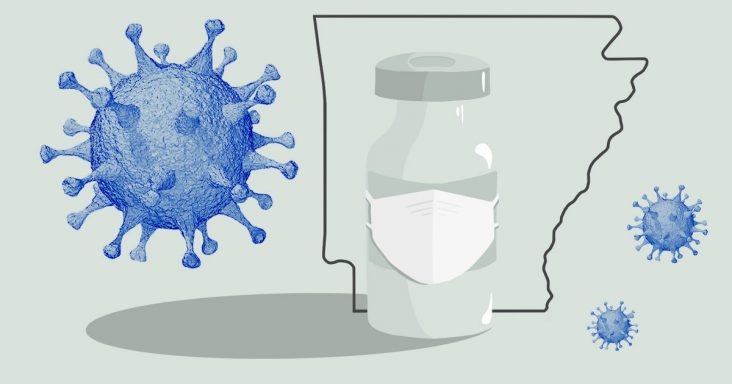Fort Smith metro COVID numbers see big decline in 2023, but virus still active
by February 27, 2024 2:51 pm 419 views

It may feel like spring has sprung, but winter viruses are still active in the Fort Smith area and Arkansas. Mercy Fort Smith is averaging four to seven patients daily with COVID. As of Feb. 20, there was a slight uptick, with nine patients hospitalized with COVID, including three in the intensive care unit.
Dr. Kevin Davis, internal medicine and infectious disease physician with Mercy Fort Smith, said in 2024, many cases of critical illness are associated with another suspected diagnosis, which would make the patient critically ill.
“Winter is associated with a wide variety of respiratory viral infections such as COVID-19, influenza, RSV, parainfluenza and others,” Davis said.
Throughout the state, COVID was on the decline in 2023, though there was a spike of the illness in December after declining numbers in October and November. The state reported 8,950 cases in December, 5,936 in November and 5,582 in October. August and September both had more than 9,000 cases reported throughout the state, according to the Arkansas Department of Health.
In 2023, there were 73,160 cases of COVID-19 reported in the state, an 82% decrease from the 398,859 cases reported in 2022. There were 559 deaths in 2023 throughout the state. In Sebastian County, there were 2,531 reported COVID cases, down 82.7% from the 14,649 reported in 2022. There were 34 COVID-related deaths in the county, down 78% from the 157 COVID-related deaths in 2022.
There were 1,135 COVID cases reported in Crawford County last year, down 83.8% from the 7,022 cases reported in the county in 2022. There were 9 COVID-related deaths in Crawford County in 2023 as compared to 87 in 2022.
Of the deaths in 2023 in the state, the majority, 464, were in the 65 and older age group. In the first six weeks of 2024, there were 4,312 cases of confirmed COVID in the state. According to the Centers for Disease Control, Arkansas reported “Very High” or 11 out of 13 for the Influenza Like Illness (ILI) for the week ending Feb. 10.
Davis said Mercy is seeing numbers of patients with winter virus illnesses to be about the same as this time last year.
“We have seen patients with each of these illnesses but the numbers are not out of the ordinary,” Davis said.
Hospital Emergency Department visits were at 10.11% for Influenza Like Illness (ILI), 3.2% for COVID Like Illness (CLI) and 0.26% for Respiratory Syncytial Virus (RSV), the CDC reported. There were a total 17,041 ER visits in Arkansas for the week of Feb. 10. Of those, 1,722 were ILI; 546 were CLI; and 45 were RSV. There were 16,340 emergency room visits throughout the state the week ending Feb. 3. Of those, 1,644 were ILI, 452 were CLI and 53 were RSV.
Outpatient visits for ILI reported were at 6.12%. And the average school absenteeism rate last week was 8.92% among public schools. Sebastian County had a 10.17% absenteeism rate for that week. Crawford County had an 8.51% absenteeism rate, according to the CDC report. Arkansas has reported 48 influenza-related deaths so far in the 2023-24 flu season. Of these, 75% were not vaccinated, according to the report.
“Nationally, CDC estimates that there have been at least 22 million illnesses, 250,000 hospitalizations, and 15,000 deaths from flu so far this season,” the report states. “Nationally, the proportion of deaths reported to the National Center for Health Statistics that were attributed to pneumonia, influenza andCOVID-19 (PIC) was above the epidemic threshold this week.”
There were 813 deaths in the state reported from all causes for the week ending Feb. 10, the CDC reported. Of those, 70 were due to pneumonia, eight were due to flu and 19 were COVID-related, the report states. There have been 48 flu deaths in the state since Oct. 1, and 88 COVID-related deaths since Jan. 1. Of the new hospital admissions throughout the state for the week of Feb. 10, 85 were flu-related and 73 were COVID-related.
“Most respiratory viral infections are spread through infected respiratory droplets or secretions. Keeping a safe distance (six or more feet) away from infected patients with a cough or runny nose and hand washing when coming in contact with infected droplets or secretions are the easiest ways to avoid contracting these types of infections,” Davis said. “Surgical masks or other masks can help if a person has to be in close contact with an infected patient.”
He said because COVID-19 is more easily transmitted than other respiratory viruses because it can have airborne transmission, basic measures may not be sufficient to protect against transmission. Maintaining further distancing or N95 masking (or equivalent) when distancing isn’t possible may be needed, he said.
“Vaccinations for RSV, influenza and COVID-19 are available. The biggest benefit to these vaccines is to prevent severe or critical illness, which would require hospitalization or ICU admission,” Davis said.
